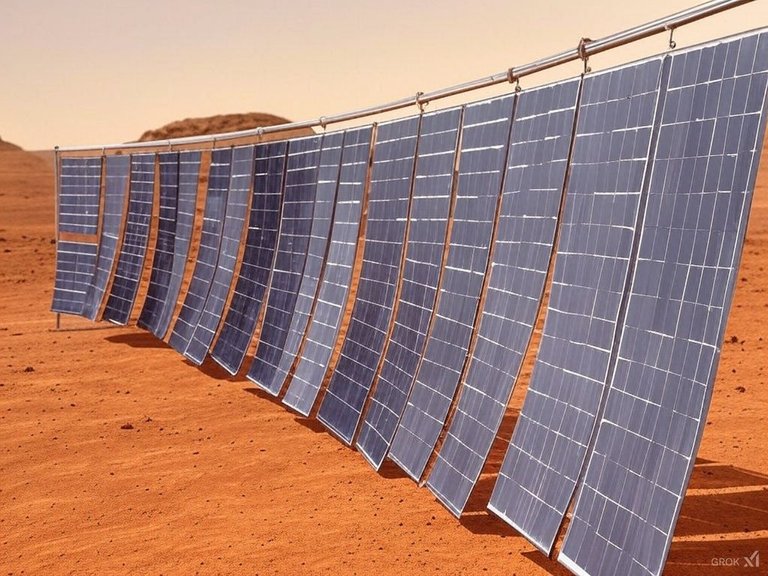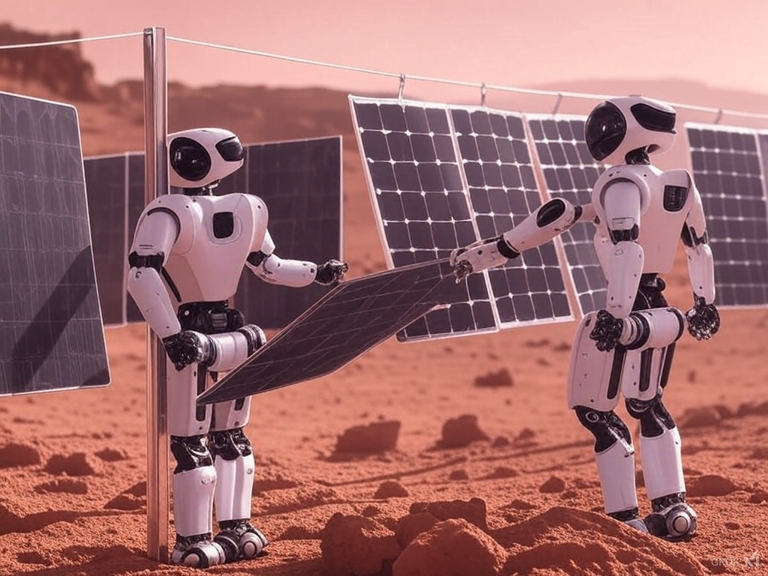New Solar Power Concept for Mars
This post by @seaexplorer got me thinking about the benefits of vertically mounted bi-facial solar panels on Mars.

[Created by Grok on my prompts]
As shown above they would be hung from a simple rail in an East-West orientation.
As has already been proven on Earth, vertically mounted bi-facial solar panels outperform perfectly sited and angled single sided panels.
Most importantly, hanging flexible bi-facial panels like washing from a line is very simple and easy to do and could be done by SpaceX Optimus robots.

[Created by Grok on my prompts]
Vertically mounted bi-facial panels have the following additional advantages on Mars:
- stay clean as dust falls off and is blown away by the light winds in the thin atmosphere - this is super important as cleaning is a huge labour & time cost in a labour constrained Mars settlement;
- are very lightweight with a much better power density than framed panels and actually far better than current nuclear tech - power density is key because tonnage to Mars is limited even with Starships
- stay cool (for better efficiency) because of excellent air-flow on both sides and because even in still conditions, warmer Mars air doesn't get trapped by the panel, it rises vertically along panel and escapes;
- production better matched to usage: they produce substantial power from the moment the sun rises and keep producing power until the sun sets, providing at least 4 hours per day of additional solar production, thus reducing the time that batteries need to cover loads - less expensive and heavy battery capacity is needed to cover night loads.
- they gain additional light from reflections from Mars surface further increasing electricity production.
While Mars is further from the sun and solar insolation is less than Earth, its atmosphere is very thin and it doesn't have substantial cloud cover so real world solar production should be similar to Earth.
It is possible that multiple Starships could land on Mars with Optimus robots in later 2026 so how to best deploy solar panels is a real & near term issue.
https://x.com/KiwiThinker/status/1877481538562175236
https://x.com/KiwiThinker/status/1891915295729840162
Please vote for my Hive witness. (KeyChain or HiveSigner)
https://www.reddit.com/r/DeutschePhotovoltaik/comments/1j02smp/new_solar_power_concept_for_mars_photovoltaik_auf/
The rewards earned on this comment will go directly to the people( @blkchn ) sharing the post on Reddit as long as they are registered with @poshtoken. Sign up at https://hiveposh.com. Otherwise, rewards go to the author of the blog post.
In theory they seem very efficient, but if there is strong wind, it would happen like with clothes, they would collide with each other and break. Perhaps better like a trampoline but vertical.
Atmospheric pressure on Mars in 1/100th of Earth's.
While there is wind, the wind pressure is around 1/100th of Earth's so will be no issue for vertically hanging solar panels, even in the most extreme conditions.
I didn't know that. So you're right, there wouldn't be a problem and they would be much more effective.
It sounds a good idea, but it would be useful to transfer that energy to earth
There is plenty of energy on Earth but Mars will be energy short for a long time. Energy = Civilisation.
Solar panels in Earth orbit beaming power to Earth have been considered but it is still far cheaper to just install solar panels on Earth.
Vertically orientated panels (solidly fixed on Earth) mean land below is still available for use.
Orbit solar panels, that's a very interesting concept!
You can read about it in Dr Robert Zubrin's new book The New World on Mars.
Thanks
Scientists think that the energy problem on Mars can be solved with solar energy. However, dust storms will reduce efficiency. If a mechanism is established to clean the dust at certain intervals, it may be useful. Another solution. Dust particles should slide on the materials to be used and fall to the ground.
Vertical panels solve the dust problem. The dust doesn't settle on the panels, it slides down the panel and falls to the ground. The slight wind pressure (thin atmosphere) also helps keep panels clean.
Cleaning panels is a massive maintenance issue in a labour constrained environment on Mars.
My concept solves this major hurdle for solar on Mars.
That is only the beginning I guess, even if they just build a place for pit stops so we spaceships can go further to explore lets say some of the Moons of Saturn or Jupiter. It is quite amazing the new ideas brought to expand our capabilities to go further in the universe.
Wow...this is impressive.. it would have been more useful here on our planet
Good idea. They plan to take solar panels anyway, so the more efficient the better.
I can just imagine the engineers during their design sessions discussing how good Optimus would be hanging things on clotheslines on Mars. 🙃
Congratulations @apshamilton! You have completed the following achievement on the Hive blockchain And have been rewarded with New badge(s)
Your next target is to reach 83000 upvotes.
You can view your badges on your board and compare yourself to others in the Ranking
If you no longer want to receive notifications, reply to this comment with the word
STOPCheck out our last posts: